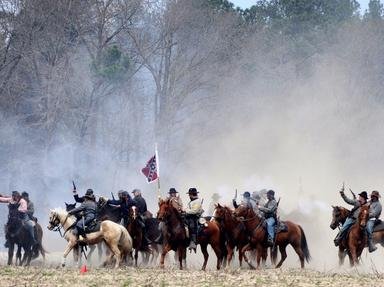Quiz Answer Key and Fun Facts
1. On what day did Major General George B. McClellan depart the Army of the Potomac for the final time, having been replaced by Major General Ambrose Burnside?
2. Burnside moved the Army of the Potomac to what small town across the Rappahannock river from Fredericksburg?
3. The first division of the Army of Northern Virginia to reach Fredericksburg (on November 20, 1862) was commanded by which man?
4. Lieutenant General Thomas "Stonewall" Jackson's men were officially incorporated into the Army of Northern Virginia as the Second Army Corps in late 1862. By what name had they been known before that time?
5. Which Union officer suggested to General Burnside that a portion of the Army ought to cross the Rappahannock near Fredericksburg before the Confederates managed to mass their army near the town?
6. Who was the wartime mayor of Fredericksburg who refused the Union demand that the city be surrendered to the Army of the Potomac?
7. Fredericksburg lay on which strategically important railroad stretching through central Virginia?
8. While the Army of Northern Virginia was organized into two Corps, or Wings, the Army of the Potomac was organized into three "Grand Divisions": Right, Left, and Center. Who commanded the Left Grand Division?
9. When Federal troops began to cross the Rappahannock River into Fredericksburg on December 11, 1862, the Confederates under James Longstreet rushed into defensive positions on which line of hills west of town?
10. Engineers from which state laid most of the pontoon bridges on which the army would cross?
11. When Confederate snipers delayed the pontoon bridges, troops from which man's brigade were landed on the far shore to drive away the enemy?
12. Federal artillery on which line of hills pummeled the town of Fredericksburg while the Federals attempted to cross the river?
13. After the Federals took the city of Fredericksburg and Barksdale's Mississippi troops retreated to join the rest of the Confederate army, the Army of the Potomac crossed in full on December 12, 1862. What did the troops do on that day that made history?
14. The major action of the battle occurred on December 13. In an attempt to turn Stonewall Jackson's line on the Confederate right, Federal troops assaulted a gap in Jackson's main line. Whose brigade was surprised and forced to retreat by this attack?
15. Jackson's line on Prospect Hill held against assaults from which two Union divisions?
16. When attacks on Stonewall Jackson's line failed, the focus of the Union effort was mounted against Longstreet's corp on the hills that governed the Confederate left. Whose Federal division was the first thrown at the heights?
17. Which Confederate artillery unit on the heights west of Fredericksburg fired on Union divisions as they marched forward to attack?
18. When attacks by division after division of Federals were all stalled, Federal troops were pinned down by fire and forced to remain on the field through 2 long, cold winter nights. On the night of December 14-15, what did they see in the sky over the field?
19. Confederate troops under Thomas R.R. Cobb held a line below Marye's Heights that repulsed the Federal attacks. What did his men use as cover from Federal fire?
20. After withdrawing back across the Rappahannock in defeat, the Federal army counted losses of nearly 13,000 men. Burnside, held personally responsible, planned to embark on a campaign to redeem himself the next January by marching his army northwest, crossing the river, and engaging Lee's forces there. This plan failed. What was it dubbed by both sides?
Source: Author
WFlanigen
This quiz was reviewed by FunTrivia editor
trammgr before going online.
Any errors found in FunTrivia content are routinely corrected through our feedback system.


